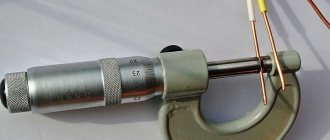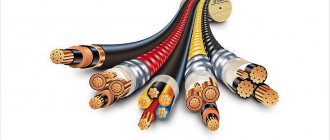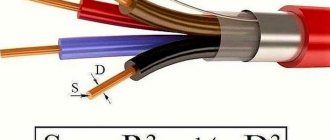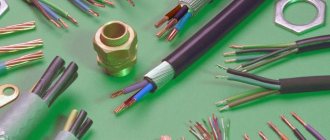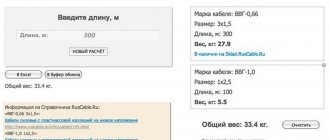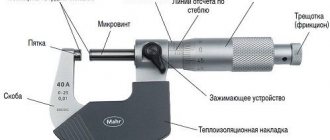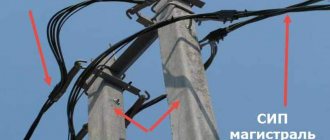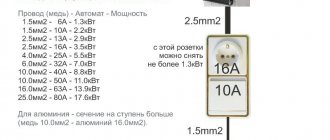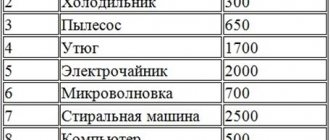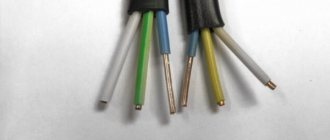We'll tell you how to calculate the cable cross-section and power by diameter - our tables and formulas will help you carry out the calculations yourself. In order to understand which wire you will need in different situations, you should distinguish the diameter of the cable cross-section. The table of values can tell amateur electricians how to choose the right cable depending on its purpose in the future - connecting powerful household appliances, large equipment, or carrying electrical wiring into the house.
To carry out the measurement procedure yourself, it will be easiest to use special instruments: for example, using a micrometer you can get the most accurate result, which cannot be achieved with a regular ruler, although it can be used for such purposes. It should be remembered that the use of improvised means requires great precision and knowledge of calculation formulas.
General information about cable and wire
When working with conductors, it is necessary to understand their designation. There are wires and cables that differ from each other in their internal structure and technical characteristics. However, many people often confuse these concepts.
A wire is a conductor that has in its design one wire or a group of wires woven together and a thin common insulating layer.
A cable is a core or a group of cores that has both its own insulation and a common insulating layer (sheath).
Each type of conductor will have its own methods for determining cross sections, which are almost similar.
Conductor materials
The amount of energy that a conductor transmits depends on a number of factors, the main one of which is the material of the current-carrying conductors.
- The following non-ferrous metals can be used as the core material of wires and cables:
- Aluminum. Cheap and lightweight conductors, which is their advantage. They are characterized by such negative qualities as low electrical conductivity, a tendency to mechanical damage, high transient electrical resistance of oxidized surfaces;
- Copper. The most popular conductors, which have a high cost compared to other options. However, they are characterized by low electrical and transition resistance at the contacts, fairly high elasticity and strength, and ease of soldering and welding;
- Aluminum copper. Cable products with aluminum cores coated with copper. They are characterized by slightly lower electrical conductivity than their copper counterparts. They are also characterized by lightness, average resistance and relative cheapness.
How and with what to measure the diameter of a wire (wire)
To measure the diameter of the wire, a caliper or micrometer of any type (mechanical or electronic) is suitable. It’s easier to work with electronic ones, but not everyone has them. You need to measure the core itself without insulation, so first move it aside or remove a small piece. This can be done if the seller allows it. If not, buy a small piece to test and take measurements on it.
On a conductor stripped of insulation, measure the diameter, after which you can determine the actual cross-section of the wire from the found dimensions. Which measuring device is better in this case? If we talk about mechanical models, then a micrometer. Its measurement accuracy is higher. If we talk about electronic options, then for our purposes they both give quite reliable results.
If you don't have a caliper or micrometer, take a screwdriver and a ruler with you. You'll have to strip a fairly decent piece of conductor, so you'll hardly be able to do without buying a test sample this time. So, remove the insulation from a 5-10 cm piece of wire.
Wind the wire around the cylindrical part of the screwdriver. Lay the coils close to each other, without a gap. All turns must be complete, that is, the “tails” of the wire must stick out in one direction - up or down, for example.
The number of turns is not important - about 10. You can have more or less, it’s just easier to divide by 10. Count the turns, then apply the resulting winding to the ruler, aligning the beginning of the first turn with the zero mark (as in the photo). Measure the length of the section occupied by the wire, then divide it by the number of turns. You get the diameter of the wire. It's that simple.
For example, let's calculate the size of the wire shown in the photo above. The number of turns in this case is 11, they occupy 7.5 mm. Divide 7.5 by 11, we get 0.68 mm. This will be the diameter of this wire. Next, you can look for the cross section of this conductor.
Methods for measuring conductor diameter
When selecting an electrical cable or wire to check the cross-section of the core, it is necessary to measure its diameter. There are several ways to do this. You can use measuring instruments such as calipers or micrometers. They measure the size of the exposed part of the conductor.
The device is simply attached to the core, clamped between the jaws, and the result is displayed on the scale. For private use, the measurements are quite accurate, with a small error. Especially if the devices are electronic.
For the second method, you only need a ruler and some kind of even rod. But in this case, you still have to do calculations, albeit very simple ones. More on this method later.
Ruler+rod
If there are no measuring instruments on the farm, you can get by with a regular ruler and any rod of the same diameter. This method has a high error, but if you try it will be quite accurate. Take a piece of wire about 10-20 cm long and remove the insulation.
We wind the bare copper or aluminum wire onto a rod of the same diameter (any screwdriver, pencil, pen, etc. will do). We lay the coils carefully, close to one another. The number of turns is 5-10-15. We count the number of full turns, take a ruler and measure the distance that the wound wire occupies on the rod. Then divide this distance by the number of turns. As a result, we obtain the diameter of the conductor.
For example, we wound 10 turns (it’s easier to count), they took up 3.8 cm (or 38 mm) on the rod. Next, we divide the distance by the number of turns, 38/10 = 3.8 mm, we get that the diameter of the wound wire is 3.8 mm.
As you can see, there is an error here. Firstly, you can lay the wire loosely. Secondly, it is not enough to take accurate measurements. But if you do everything carefully, the discrepancies with the actual sizes will not be so large.
Application of measuring instruments
To determine the diameter of the cores of wires and cables, various measuring instruments are widely used, showing the most accurate results. Basically, the use of micrometers and calipers is practiced for these purposes. Despite their high efficiency, a significant drawback of these devices is their high cost, which is of great importance if the tool is planned to be used only 1-2 times.
As a rule, professional electricians who are constantly engaged in electrical installation work use special devices. With the right approach, it becomes possible to measure the diameter of wire cores even on working lines.
What is a section
But first, let's understand the concepts. Cross-section is the cross-sectional area of a wire, which can be easily measured by cutting the cable in half. Only the size of the copper or aluminum conductor is included in the value, and the insulating layer is not taken into account.
To find out what the cut area of a particular conductor is, you can look at the table of cross-sections of wires of a certain type, brand and manufacturer. There you can also see the influence of this value on other operational characteristics of the cable.
For example, the larger the section, the higher it is:
- Rated voltage;
- Maximum load;
- Thickness of the insulating layer.
That is, if you do not pay due attention to the calculation and selection of the cross-section, and connect wires of different cross-sections into one line, you can build a conductor with completely opposite, inappropriate and inappropriate parameters into the existing wiring. The result will be disastrous: current leakage, short circuit, risk to life, health and property of residents.
About choosing a cable brand for home wiring
Making apartment electrical wiring from aluminum wires at first glance seems cheaper, but operating costs due to low reliability of contacts over time will be many times higher than the costs of electrical wiring made from copper.
It is recommended to make wiring exclusively from copper wires! Aluminum wires are indispensable when laying overhead electrical wiring, as they are light and cheap and, when properly connected, serve reliably for a long time.
Which wire is better to use when installing electrical wiring, single-core or stranded? From the point of view of the ability to conduct current per unit of cross-section and installation, single-core is better. So for home wiring you only need to use solid wire.
Stranded allows multiple bends, and the thinner the conductors in it, the more flexible and durable it is. Therefore, stranded wire is used to connect non-stationary electrical appliances to the electrical network, such as an electric hair dryer, an electric razor, an electric iron and all the others.
After deciding on the cross-section of the wire, the question arises about the brand of cable for electrical wiring. The choice here is not great and is represented by only a few brands of cables: PUNP, VVGng and NYM.
PUNP cable since 1990, in accordance with the decision of Glavgosenergonadzor “On the ban on the use of wires such as APVN, PPBN, PEN, PUNP, etc., produced according to TU 16-505. 610-74 instead of APV, APPV, PV and PPV wires according to GOST 6323-79*" is prohibited for use.
Cable VVG and VVGng - copper wires in double polyvinyl chloride insulation, flat shape. Designed for operation at ambient temperatures from −50°С to +50°С, for wiring inside buildings, outdoors, in the ground when laid in tubes. Service life up to 30 years.
The letters “ng” in the brand designation indicate the non-flammability of the wire insulation. Two-, three- and four-core wires are available with core cross-sections from 1.5 to 35.0 mm2. If in the cable designation there is a letter A (AVVG) before VVG, then the conductors in the wire are aluminum.
The NYM cable (its Russian analogue is the VVG cable) with round copper cores with non-flammable insulation, complies with the German standard VDE 0250. Technical characteristics and scope of application are almost the same as the VVG cable. Two-, three- and four-core wires are available with core cross-sections from 1.5 to 4.0 mm2.
As you can see, the choice for laying electrical wiring is not large and is determined depending on what shape the cable is more suitable for installation, round or flat. A round-shaped cable is more convenient to lay through walls, especially if the connection is made from the street into the room. You will need to drill a hole slightly larger than the diameter of the cable, and with a larger wall thickness this becomes relevant. For internal wiring, it is more convenient to use a VVG flat cable.
Features of calculating the power of hidden wiring
If the design documentation implies the use of hidden wiring, then it is necessary to purchase cable products “with a reserve” - about 20–30% should be added to the obtained value of the cable cross-section. This is done to avoid heating the cable during operation. The fact is that in conditions of cramped space and lack of air access, heating of the cable occurs much more intensely than when installing open wiring. If in closed channels it is planned to lay not one cable, but several at once, then the cross-section of each wire should be increased by at least 40%. It is also not recommended to tightly lay various wires - ideally, each cable should be contained in a corrugated pipe, which provides it with additional protection.
Important! It is by the value of power consumption that professional electricians are guided when choosing a cable cross-section, and only this method is correct.
Dependence of current, power and core cross-section
It is not enough to measure and calculate the cross-sectional area of the cable based on the diameter of the core. Before installing wiring or other types of electrical networks, it is also necessary to know the capacity of the cable products.
- When choosing a cable, you must be guided by several criteria:
- the strength of the electric current that the cable will pass;
- consumer power;
- current load exerted on the cable.
Power
The most important parameter during electrical installation work (in particular, cable laying) is throughput. The maximum power of electricity transmitted through it depends on the cross-section of the conductor. Therefore, it is extremely important to know the total power of the energy consumption sources that will be connected to the wire.
Typically, manufacturers of household appliances, appliances and other electrical products indicate on the label and in the documentation accompanying them the maximum and average power consumption.
For example, a washing machine can consume electricity ranging from tens of W/h during rinsing mode to 2.7 kW/h when heating water.
Accordingly, a wire with a cross-section that is sufficient to transmit electricity of maximum power must be connected to it. If two or more consumers are connected to the cable, then the total power is determined by adding the limit values of each of them.
The average power of all electrical appliances and lighting devices in an apartment rarely exceeds 7500 W for a single-phase network. Accordingly, the cable cross-sections in the electrical wiring must be selected to this value.
It is recommended to round the cross-section towards higher power due to a possible increase in power consumption in the future. Typically, the next largest cross-sectional area from the calculated value is taken. So, for a total power of 7.5 kW, it is necessary to use a copper cable with a core cross-section of 4 mm2, which is capable of transmitting about 8.3 kW. The cross-section of the conductor with an aluminum core in this case must be at least 6 mm2, passing a current power of 7.9 kW.
In individual residential buildings, a three-phase power supply system of 380 V is often used. However, most equipment is not designed for such electrical voltage. A voltage of 220 V is created by connecting them to the network through a neutral cable with an even distribution of the current load across all phases.
Electric current
Often the power of electrical equipment and equipment may not be known to the owner due to the absence of this characteristic in the documentation or completely lost documents and labels. There is only one way out in such a situation - to calculate using the formula yourself.
Power is determined by the formula:
P = U*I
- Where:
- P – power, measured in watts (W);
- I – electric current strength, measured in amperes (A);
- U is the applied electrical voltage, measured in volts (V).
- When the strength of the electric current is unknown, it can be measured using instrumentation:
- ammeter;
- multimeter;
- current clamps.
After determining the power consumption and electric current, you can use the table below to find out the required cable cross-section.
Load
Calculation of the cross-section of cable products based on current load must be carried out to further protect them from overheating. When too much electric current passes through conductors for their cross-section, destruction and melting of the insulating layer can occur.
The maximum permissible long-term current load is the quantitative value of the electric current that can pass the cable for a long time without overheating. To determine this indicator, it is initially necessary to sum up the powers of all energy consumers.
After this, calculate the current load using the formulas:
single-phase network: I = P∑*Ki/U
three-phase network: I = P∑*Ki/(√3*U)
- Where:
- P∑ – total power of energy consumers;
- Ki – coefficient equal to 0.75;
- U – electrical voltage in the network.
How to calculate power consumption
You can calculate the approximate cable cross-section yourself - it is not necessary to seek the help of a qualified specialist. The data obtained as a result of the calculations can be used to purchase wires, however, the electrical installation work itself should be trusted only to an experienced person.
The sequence of actions when calculating the section is as follows:
- A detailed list of all electrical appliances in the room is compiled.
- The passport data of the power consumption of all found devices is established, after which the continuity of operation of a particular equipment is determined.
- Having identified the value of power consumption from devices that operate constantly, you should sum this value by adding to it a coefficient equal to the value of electrical appliances that turn on periodically (that is, if the device will work only 30% of the time, then you should add a third of its power).
- Next, we look for the obtained values in a special table for calculating the wire cross-section. For greater guarantee, it is recommended to add 10-15% to the obtained power consumption value.
To determine the necessary calculations for selecting the cross-section of electrical wiring cables according to their power within the network, it is important to use data on the amount of electrical energy consumed by devices and current appliances. At this stage, it is necessary to take into account a very important point - the data of electrically consumed devices does not give an exact, but an approximate, average value
Therefore, to this mark it is necessary to add about 5% of the parameters specified by the equipment manufacturer
At this stage, it is necessary to take into account a very important point - the data of electrically consumed devices does not give an exact, but an approximate, average value. Therefore, about 5% of the parameters specified by the equipment manufacturer must be added to this mark.
The majority of not the most competent and qualified electricians are confident in one simple truth - in order to correctly install electrical wires for lighting sources (for example, for lamps), it is necessary to take wires with a cross-section equal to 0.5 mm², for chandeliers - 1, 5 mm², and for sockets – 2.5 mm².
Only incompetent electricians think about this and think so. But what if, for example, a microwave, kettle, refrigerator and lighting operate simultaneously in the same room, which require wires with different cross-sections? This can lead to a variety of situations: short circuit, rapid damage to wiring and insulating layer, as well as fire (this is a rare case, but still possible).
Exactly the same not very pleasant situation can happen if a person connects a multicooker, a coffee maker and, say, a washing machine to the same outlet.
Stranded wire
The PVS cable for connecting power tools and electrical appliances is made flexible, since all the cores are stranded. Measuring the diameter of the harness at the same time will give an incorrect result, since there are air gaps inside. The correct calculation principle is the same as for cable.
The core should be fluffed up, count how many wires are in it, and then measure the diameter of one of them. Knowing their total number in the vein, you can calculate the total cross-section using the previous formula. It’s best to take measurements using a micrometer. It is more convenient to use, since the caliper easily presses through thin wires.
How to calculate the cross-section of a stranded wire
Stranded wire, or as it is also called stranded or flexible, is a single-core wire twisted together. To calculate the cross-section of a stranded wire, you must first calculate the cross-section of one wire, and then multiply the resulting result by their number.
Let's look at an example. There is a multi-core flexible wire, in which there are 15 cores with a diameter of 0.5 mm. The cross-section of one core is 0.5 mm × 0.5 mm × 0.785 = 0.19625 mm2, after rounding we get 0.2 mm2. Since we have 15 wires in the wire, to determine the cable cross-section we need to multiply these numbers. 0.2 mm2×15=3 mm2. It remains to determine from the table that such a stranded wire will withstand a current of 20 A.
You can estimate the load capacity of a stranded wire without measuring the diameter of an individual conductor by measuring the total diameter of all twisted wires. But since the wires are round, there are air gaps between them. To eliminate the gap area, you need to multiply the result of the wire cross-section obtained from the formula by a factor of 0.91. When measuring the diameter, you need to make sure that the stranded wire does not flatten.
Let's look at an example. As a result of measurements, the stranded wire has a diameter of 2.0 mm. Let's calculate its cross-section: 2.0 mm × 2.0 mm × 0.785 × 0.91 = 2.9 mm2. Using the table (see below), we determine that this stranded wire will withstand a current of up to 20 A.
Why do you need an exact value?
Find out the cross-section of the cables being purchased in order to select the one suitable for a specific purpose. If the conductor does not comply with this parameter, then there is an increased risk of fire. So, you cannot take a cable or electrical wire whose parameter is below the permissible norm, as it will become very hot during operation. Such heating will gradually reduce the safety margin of the insulation and, as a result, its breakdown and, possibly, subsequent fire will occur.
In addition to the need to double-check the values specified in the specification when purchasing a new wire, you may need to find out the exact cross-section in other situations. One of the most common is the need to replace an already used conductive element. Its parameters cannot be viewed, since such information is rarely remembered or saved somewhere written down. If you take a new wire “by eye”, it is also possible that it will catch fire after commissioning.
Undersized wire cross-section - what is the danger?
So, let's consider the dangers that await us when using low-quality wires in everyday life. It is clear that the current characteristics of current-carrying conductors decrease in direct proportion to the decrease in their cross-section. The load capacity of the wire decreases due to the reduced cross-section. According to the standards, the current that the wire can pass through is calculated. It will not collapse if less current passes through it.
The resistance between the cores decreases if the insulation layer is thinner than required. Then, in an emergency situation, when the supply voltage increases, a breakdown may occur in the insulation. If, along with this, the core itself has a reduced cross-section, that is, it cannot pass the current that, according to standards, it should pass, the thin insulation begins to gradually melt.
All these factors will inevitably lead to a short circuit and then to a fire. A fire occurs from sparks that appear during a short circuit. Let me give you an example: a three-core copper wire (for example, with a cross-section of 2.5 2), according to regulatory documentation, can pass 27 A for a long time, usually 25 A is considered.
But the wires that come into my hands, produced in accordance with the specifications, actually have a cross-section from 1.8 mm2 to 2 mm2 (this is with the declared 2.5 mm2). Based on the regulatory documentation, a wire with a cross-section of 2 mm2 can carry a current of 19 A for a long time.
Therefore, if a situation occurs when a current designed for such a cross-section flows through the wire you have chosen, which supposedly has a cross-section of 2.5 mm2, the wire will overheat. And with prolonged exposure, the insulation will melt, followed by a short circuit.
Contact connections (for example, in a socket) will collapse very quickly if such overloads occur regularly. Therefore, the socket itself, as well as the plugs of household appliances, may also be subject to melting.
Now imagine the consequences of all this! It’s especially disappointing when a beautiful renovation has been made, new appliances have been installed, for example, an air conditioner, an electric oven, a hob, a washing machine, an electric kettle, a microwave oven. And so you put the buns in the oven to bake, started the washing machine, turned on the kettle, and even the air conditioner, since it became hot.
These switched on devices are enough to cause smoke to come out of junction boxes and sockets. Then you will hear a pop, which is accompanied by a flash. And after that the electricity will disappear. It will still end well if you have circuit breakers.
What if they are of low quality? Then you won't get away with a bang and a flash. A fire will start, accompanied by sparks from the wiring burning in the wall. The wiring will burn in any case, even if it is tightly walled under the tile.
The picture I described makes it clear how responsibly you need to choose wires. After all, you will use them in your home. This is what it means to follow not GOSTs, but TUs.
Why do you need to calculate the cable load?
This question often arises when installing wiring in an apartment or home. First, all planned loads are considered, and then the required wire cross-section is determined. Then the necessary material is purchased from the store and electrical wiring is installed in the house.
As a result of using new wiring, the circuit breaker on the electrical panel first “knocks out”, and then damage to the wire is discovered. Moreover, it often turns out to be completely melted, as a result of which a short circuit occurs. It turns out that the calculations were made incorrectly, and how can you find out the minimum permissible value of the wire cross-section in this case?
To avoid serious overloads, it is necessary to calculate how many electrical appliances in the apartment will be used simultaneously. Among the most powerful household appliances that are usually used at home when preparing food and creating our comfort are:
- electric stove;
- air conditioner;
- microwave;
- electric kettle;
- iron;
- washing machine and dishwasher;
- coffee grinder;
- vacuum cleaner.
The power consumption of these household appliances ranges from 1 to 2 kilowatts (with the exception of electric stoves).
Calculation of the cross-section of electrical wiring according to the power of connected electrical appliances
To select the cross-section of cable wire cores when laying electrical wiring in an apartment or house, you need to analyze the fleet of existing electrical household appliances from the point of view of their simultaneous use. The table provides a list of popular household electrical appliances indicating the current consumption depending on the power.
You can find out the power consumption of your models yourself from the labels on the products themselves or data sheets; often the parameters are indicated on the packaging. If the current consumed by an electrical appliance is not known, it can be measured using an ammeter.
Table of power consumption and current for household electrical appliances at a supply voltage of 220 V
Typically, the power consumption of electrical appliances is indicated on the housing in watts (W or VA) or kilowatts (kW or kVA). 1 kW=1000 W.
Table of power/current consumption of household electrical appliances
| electrical appliance | Power consumption, W | Current strength, A |
| Washing machine | 2000 – 2500 | 9,0 – 11,4 |
| Jacuzzi | 2000 – 2500 | 9,0 – 11,4 |
| Electric floor heating | 800 – 1400 | 3,6 – 6,4 |
| Stationary electric stove | 4500 – 8500 | 20,5 – 38,6 |
| microwave | 900 – 1300 | 4,1 – 5,9 |
| Dishwasher | 2000 – 2500 | 9,0 – 11,4 |
| Freezers, refrigerators | 140 – 300 | 0,6 – 1,4 |
| Electric meat grinder | 1100 – 1200 | 5,0 – 5,5 |
| Electric kettle | 1850 – 2000 | 8,4 – 9,0 |
| Electric coffee maker | 630 – 1200 | 3,0 – 5,5 |
| Juicer | 240 – 360 | 1,1 – 1,6 |
| Toaster | 640 – 1100 | 2,9 – 5,0 |
| Mixer | 250 – 400 | 1,1 – 1,8 |
| Hairdryer | 400 – 1600 | 1,8 – 7,3 |
| Iron | 900 –1700 | 4,1 – 7,7 |
| Vacuum cleaner | 680 – 1400 | 3,1 – 6,4 |
| Fan | 250 – 400 | 1,0 – 1,8 |
| TV | 125 – 180 | 0,6 – 0,8 |
| Radio equipment | 70 – 100 | 0,3 – 0,5 |
| Lighting devices | 20 – 100 | 0,1 – 0,4 |
Current is also consumed by the refrigerator, lighting fixtures, radiotelephone, chargers, and TV in standby mode. But in total this power is no more than 100 W and can be ignored in calculations.
If you turn on all the electrical appliances in the house at the same time, you will need to select a wire cross-section capable of passing a current of 160 A. You will need a finger-thick wire! But such a case is unlikely. It’s hard to imagine that someone is capable of grinding meat, ironing, vacuuming and drying hair at the same time.
Calculation example. You got up in the morning, turned on the electric kettle, microwave, toaster and coffee maker. The current consumption will accordingly be:
7 A + 8 A + 3 A + 4 A = 22 A
Taking into account the switched on lighting, refrigerator and, in addition, for example, a TV, the current consumption can reach 25 A.
Selecting a wire cross-section for connecting electrical appliances to a three-phase 380 V network
When operating electrical appliances, for example, an electric motor, connected to a three-phase network, the consumed current no longer flows through two wires, but through three and, therefore, the amount of current flowing in each individual wire is somewhat less. This allows you to use a smaller cross-section wire to connect electrical appliances to a three-phase network.
To connect electrical appliances to a three-phase network with a voltage of 380 V, for example an electric motor, the wire cross-section for each phase is taken 1.75 times less than for connecting to a single-phase 220 V network. Attention, when choosing the wire cross-section for connecting an electric motor by power, you should take into account that The motor nameplate indicates the maximum mechanical power that the motor can produce at the shaft, not the electrical power consumed.
The electrical power consumed by the electric motor, taking into account efficiency and cos φ, is approximately two times greater than that created on the shaft, which must be taken into account when choosing the wire cross-section based on the motor power indicated on the plate.
For example, you need to connect an electric motor that consumes power from a 2.0 kW network. The total current consumption of an electric motor of such power in three phases is 5.2 A. According to the table, it turns out that a wire with a cross-section of 1.0 mm2 is needed, taking into account the above 1.0 / 1.75 = 0.5 mm2. Therefore, to connect a 2.0 kW electric motor to a three-phase 380 V network, you will need a three-core copper cable with a cross-section of each core of 0.5 mm2.
It is much easier to choose the wire cross-section for connecting a three-phase motor based on the current consumption, which is always indicated on the nameplate. For example, the current consumption of a 0.25 kW motor for each phase at a supply voltage of 220 V (the motor windings are connected in a delta configuration) is 1.2 A, and at a voltage of 380 V (the motor windings are connected in a star configuration) it is only 0.7 A.
Taking the current strength indicated on the nameplate, according to the table for selecting the wire cross-section for apartment electrical wiring, we select a wire with a cross-section of 0.35 mm2 when connecting the electric motor windings in a “triangle” pattern or 0.15 mm2 when connecting in a “star” pattern.
P=IU
These formulas are used in cases of active load (consumers in residential premises, light bulbs, irons). For reactive loads, a coefficient of 0.7 to 0.9 is mainly used (for the operation of powerful transformers, electric motors, usually in industry).
The following table suggests the initial parameters - current consumption and power, and the determined values - wire cross-section and tripping current of the protective circuit breaker.
Based on the power consumption and current, select the cross-sectional area of the wire and the circuit breaker.
Knowing the power and current, you can select the wire cross-section in the table below.
Table 2.
| Max. power, kWt | Max. load current, A | Wire cross-section, mm2 | Circuit breaker current, A |
| 1 | 4.5 | 1 | 4-6 |
| 2 | 9.1 | 1.5 | 10 |
| 3 | 13.6 | 2.5 | 16 |
| 4 | 18.2 | 2.5 | 20 |
| 5 | 22.7 | 4 | 25 |
| 6 | 27.3 | 4 | 32 |
| 7 | 31.8 | 4 | 32 |
| 8 | 36.4 | 6 | 40 |
| 9 | 40.9 | 6 | 50 |
| 10 | 45.5 | 10 | 50 |
| 11 | 50.0 | 10 | 50 |
| 12 | 54.5 | 16 | 63 |
| 13 | 59.1 | 16 | 63 |
| 14 | 63.6 | 16 | 80 |
| 15 | 68.2 | 25 | 80 |
| 16 | 72.7 | 25 | 80 |
| 17 | 77.3 | 25 | 80 |
Critical cases in the table are highlighted in red; in these cases, it is better to play it safe without saving on the wire, choosing a thicker wire than indicated in the table. On the contrary, the current of the machine is less.
Using the table, you can easily select the wire cross-section by current, or the wire cross-section by power. Select a circuit breaker for the given load.
In this table, all data is given for the following case.
- Single phase, voltage 220 V
- Ambient temperature +300С
- Laying in the air or in a box (located in a closed space)
- Three-core wire, in general insulation (wire)
- The most common TN-S system is used with a separate ground wire
- In very rare cases the consumer reaches maximum power. In such cases, the maximum current can operate for a long time without negative consequences.
It is recommended to choose a larger cross-section (next from the series), in cases where the ambient temperature is 200C higher, or there are several wires in the harness
This is especially important in cases where the operating current is close to the maximum
In doubtful and controversial points, such as:
high starting currents; possible future increase in load; fire hazardous premises; large temperature changes (for example, the wire is in the sun), it is necessary to increase the thickness of the wires. Or, for reliable information, refer to formulas and reference books. But basically, tabular reference data is applicable for practice.
You can also find out the thickness of the wire using an empirical (experienced) rule:
The rule for choosing the cross-sectional area of the wire for the maximum current.
The required cross-sectional area for a copper wire, based on the maximum current, can be selected using the rule:
The required wire cross-sectional area is equal to the maximum current divided by 10.
Calculations according to this rule do not have a margin, so the result must be rounded up to the nearest standard size. For example, you need a wire with a cross-section of mm, and a current of 32 Amps. It is necessary to take the nearest one, of course, in the larger direction - 4 mm. It can be seen that this rule fits well into the tabular data.
It should be noted that this rule works well for currents up to 40 Amperes. If the currents are greater (outside the living room, such currents are at the input) - you need to choose a wire with an even larger margin, and divide not by 10, but by 8 (up to 80 A).
The same rule applies to finding the maximum current through a copper wire if its area is known:
The maximum current is equal to the cross-sectional area, multiplied by 10.
Cable cross-section by diameter table
Knowing the diameter of the wire, you can determine its cross-section using a ready-made dependence table. The table for calculating the cable cross-section by core diameter looks like this:
Table of cross-section versus diameter
| Conductor diameter, mm | Conductor cross-section, mm2 |
| 0,8 | 0,5 |
| 1 | 0,75 |
| 1,1 | 1 |
| 1,.2 | 1,2 |
| 1,.4 | 1,5 |
| 1,6 | 2 |
| 1,8 | 2,5 |
| 2 | 3 |
| 2,3 | 4 |
| 2,5 | 5 |
| 2,.8 | 6 |
| 3,2 | 8 |
| 3,6 | 10 |
| 4,5 | 16 |
Wire cross-section and power table
When the cross-section is known, it is possible to determine the permissible power and current values for copper or aluminum wire. In this way, it will be possible to find out what load parameters the current-carrying core is designed for. To do this, you will need a table of the dependence of the cross section on the maximum current and power.
Table of power and current values from the cross-section for hidden wiring with a single-phase 220 V connection diagram
| Wire core cross-section, mm2 | Conductor core diameter, mm | Copper conductors | Aluminum conductors | ||
| Current, A | Power, W | Current, A | Power, W | ||
| 0.5 | 0.8 | 6 | 1300 | ||
| 0.75 | 0.98 | 10 | 2200 | ||
| 1 | 1.13 | 14 | 3100 | ||
| 1.5 | 1.38 | 15 | 3300 | 10 | 2200 |
| 2 | 1.6 | 19 | 4200 | 14 | 3100 |
| 2.5 | 1.78 | 21 | 4600 | 16 | 3500 |
| 4 | 2.26 | 27 | 5900 | 21 | 4600 |
| 6 | 2.76 | 34 | 7500 | 26 | 5700 |
| 10 | 3.57 | 50 | 11000 | 38 | 8400 |
| 16 | 4.51 | 80 | 17600 | 55 | 12100 |
| 25 | 5.64 | 100 | 22000 | 65 | 14300 |
As we can see from the table, the cross-section of the cores depends, in addition to the load, on the material from which the wire is made.
Table of power and current values from the cross-section for hidden wiring with a three-phase connection diagram of 380 V
| Wire core cross-section, mm2 | Conductor core diameter, mm | Copper conductors | Aluminum conductors | ||
| Current, A | Power, W | Current, A | Power, W | ||
| 0.5 | 0.8 | 6 | 2250 | ||
| 0.75 | 0.98 | 10 | 3800 | ||
| 1 | 1.13 | 14 | 5300 | ||
| 1.5 | 1.38 | 15 | 5700 | 10 | 3800 |
| 2 | 1.6 | 19 | 7200 | 14 | 5300 |
| 2.5 | 1.78 | 21 | 7900 | 16 | 6000 |
| 4 | 2.26 | 27 | 10000 | 21 | 7900 |
| 6 | 2.76 | 34 | 12000 | 26 | 9800 |
| 10 | 3.57 | 50 | 19000 | 38 | 14000 |
| 16 | 4.51 | 80 | 30000 | 55 | 20000 |
| 25 | 5.64 | 100 | 38000 | 65 | 24000 |
Pivot table
There are tables that allow you to determine the required cross-section using several parameters at once - current, power, conductor material, and so on. They are more convenient to use and one of them is located below. It indicates the cross-section of the wire in terms of current and power, and also takes into account the installation method.
Wire cross-section by current and power - table for copper and aluminum conductorsSource tvz2.ru
Perhaps the article came out a little boring and full of technical terms. However, the information contained in it should not be neglected. Since the reliability and safety of the functioning of the home electrical network depends on how correctly the wiring was chosen.
Parallel connection of electrical wiring wires
There are hopeless situations when you urgently need to lay wiring, but there is no wire of the required cross-section available. In this case, if there is a wire with a smaller cross-section than necessary, then the wiring can be made from two or more wires, connecting them in parallel. The main thing is that the sum of the sections of each of them is not less than the calculated one.
For example, there are three wires with a cross section of 2, 3 and 5 mm2, but according to calculations, 10 mm2 is needed. Connect them all in parallel and the wiring will handle up to 50 amps. Yes, you yourself have repeatedly seen the parallel connection of a large number of thin conductors to transmit large currents.
For example, welding uses a current of up to 150 A and in order for the welder to control the electrode, a flexible wire is needed. It is made from hundreds of thin copper wires connected in parallel. In a car, the battery is also connected to the on-board network using the same flexible stranded wire, since when starting the engine, the starter consumes a current of up to 100 A from the battery.
And when installing and removing the battery, it is necessary to move the wires to the side, that is, the wire must be flexible enough. The method of increasing the cross-section of an electrical wire by connecting several wires of different diameters in parallel can be used only as a last resort. When laying home electrical wiring, it is permissible to connect in parallel only wires of the same cross-section taken from the same reel.
Author: Sergey Vladimirovich, electrical engineer. More about the author.
Connect wires of different sections using bolts
Another way to connect wires of different sections to each other is to create contact using bolts, washers and nuts. According to professional electricians, this connection is the most durable and strong. The process itself is not too complicated and takes minimal time. The procedure goes as follows:
- the copper conductors of the wire are carefully stripped (the length of the stripped section of the conductor depends on the diameter of the bolt);
- the stripped core is bent into a loop;
- the loop is put on the bolt;
- an intermediate washer is installed on top;
- then a loop of wire of a different cross-section is put on and secured with an intermediate washer.
This continues until all the wires are connected to each other. After putting on the last loop and the last washer, the structure is firmly tightened with a nut.
